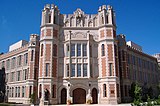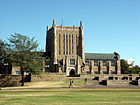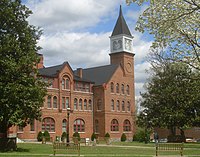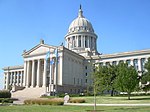Selected article
The Cherokee are a people from North America, who at the time of European contact in the 1600s, inhabited what is now the Eastern and Southeastern United States. Most were forcibly moved westward to the Ozark Plateau. They were one of the tribes referred to as the Five Civilized Tribes. According to the 2000 U.S. Census, they are the most numerous of the 563 federally recognized Native American tribes in the United States.
Of the southeastern Indian confederacies of the late 1600s and early 1700s (Creek, Chickasaw, Choctaw, etc), the Cherokee were one of the most populous and powerful, and were relatively isolated due to their hilly and mountainous homeland. Beginning at about the time of the American Revolutionary War in the late 18th century, divisions over continued accommodation of encroachments by white settlers, despite repeated violations of previous treaties, caused some Cherokee to begin to leave the Cherokee Nation. Many of these dissidents became known as the Chickamauga. Led by Chief Dragging Canoe, the Chickamauga made alliances with the Shawnee and engaged in raids against colonial settlements (see Cherokee–American wars). Some of these early dissidents eventually moved across the Mississippi River to areas that would later become the states of Arkansas and Missouri. Their settlements were established on the St. Francis and the White Rivers by 1800.
The Trail of tears displaced the Cherokee's from their ancestral lands in North Georgia and the Carolinas to Oklahoma. In 1887 the Dawes Act broke up the tribal land base. Under the Curtis Act of 1898, Cherokee courts and governmental systems were abolished by the U.S. Federal Government. (Read more . . . )Portal:Oklahoma/Selected article/2
Ed Galloway's Totem Pole Park consists of eleven objects and one building on 14 acres (57,000 m²) in Rogers County, Oklahoma. The park is ten miles (16 km) north-east of Claremore and is located 3.5 miles (6 km) east of historic U.S. Route 66 and Foyil. It was added to the National Register of Historic Places on 30 March 1999 and is currently owned and operated by the Rogers County Historical Society and the Foyil Heritage Association. The park's main totem pole is claimed to be the "World’s Largest Concrete Totem Pole."
After more than 20 years as a manual arts teacher at the Children’s Home orphanage in Sand Springs, OK, in 1937 Ed Galloway retired and moved his family to a small farm near Foyil. Shortly afterwards he embarked on an ambitious folk art project to create a three-dimensional totem pole using modern building materials. After eleven years of work, Galloway’s totem pole was completed in 1948 and topped out at approximately 90 ft (27 m) in height. The totem pole’s construction took six tons of steel, 28 tons of cement, and 100 tons of sand and rock. The base is 30 ft (9 m) wide and rests on the back of a colourfully painted turtle. It is decorated with approximately 200 bas relief images of brightly colored Native American portraits, symbols, and animal figures that cover the entire totem pole from the base to its pinnacle. (Read more...)Portal:Oklahoma/Selected article/3
The Dust Bowl was a series of dust storms causing major ecological and agricultural damage to American and Canadian prairie lands from 1930 to 1936 (in some areas until 1940), caused by severe drought conditions coupled with decades of extensive farming without crop rotation or other techniques that prevented erosion. The fertile soil of the Great Plains was exposed through removal of grass during plowing. During the drought, soil dried out, became dust, and blew away eastwards and southwards, mostly in large black clouds. At times, the clouds blackened the sky all the way to Chicago, and much of the soil was completely deposited into the Atlantic Ocean.
This ecological catastrophe, which began as the economic effects of the Great Depression were intensifying, caused an exodus from Texas, Oklahoma, and the surrounding Great Plains, with over 500,000 Americans left homeless. (Read more...)Portal:Oklahoma/Selected article/4
The Oklahoma City bombing was a terrorist attack on April 19, 1995 aimed at the Alfred P. Murrah Federal Building, a U.S. government office complex in downtown Oklahoma City, Oklahoma. The attack claimed 168 lives and left over 800 injured. Until the September 11, 2001 attacks, it was the deadliest act of terrorism on U.S. soil. It remains as the deadliest act of domestic terrorism in U.S. history.
Just 90 minutes after the explosion, an Oklahoma Highway Patrol officer pulled over 27-year old Timothy McVeigh for driving without a license plate. Within days after the bombing, Timothy McVeigh and Terry Nichols were both arrested for their roles in the bombing. Investigators determined that McVeigh and Nichols were sympathizers of an anti-government militia movement and that their motive was to avenge the government's handling of the Waco and Ruby Ridge incidents. McVeigh was executed by lethal injection on June 11, 2001; Nichols was sentenced to life in prison. A third conspirator, Michael Fortier, who testified against the two conspirators, was imprisoned for failing to warn the U.S. government. As with other large-scale terrorist attacks, conspiracy theories dispute the official claims and point to additional perpetrators involved.
The attacks led to the U.S. government passing legislation designed to increase protection around federal buildings and to thwart future terrorist attacks. Under these measures, law enforcement has since foiled over fifty domestic terrorism plots.
On April 19, 2000, the Oklahoma City National Memorial was dedicated on the site of the Murrah Federal Building to commemorate the victims of the bombing. (Read more...)Portal:Oklahoma/Selected article/5
The Comanche are a Native American group whose historical range (the Comancheria) consisted of present-day Eastern New Mexico, Southern Colorado, Southern Kansas, all of Oklahoma, and most of Northern and Southern Texas. There might once have been as many as 20,000 Comanches. Today, the Comanche Nation consists of approximately 10,000 members, about half of whom live in Oklahoma (centered at Lawton), with the remainder concentrated in Texas, California, and New Mexico.
There are various accounts of the origin of the name Comanche. Perhaps the most widely accepted is that it derives from Komantcia, a Spanish corruption of "Kohmahts", the Ute name for the people. "Kohmahts" is variously translated as "enemy", "those who want to fight (us)", "those who are against us", or "strangers". Alternatively the name may come from the Spanish camino ancho, meaning "wide trail". Early French and American explorers knew the Comanche as Padouca (or Paducah), their Siouan name. The Comanches' own preferred name is NPortal:Oklahoma/Selected article/6
The University of Oklahoma, often called OU or Oklahoma, is a coeducational public research university located in the U.S. state of Oklahoma. The university was founded in 1890. It currently enrolls 30,447 students (with a vast majority of those located at its main campus in Norman, Oklahoma), has over 2,000 full-time faculty members, and offers 153 baccalaureate programs, 152 master's programs, 75 doctorates, 20 majors at the first professional level, and 18 graduate certificates. David Boren is the president of OU, a position he accepted in 1994.
The Princeton Review recently named OU as one of its "Best Value" colleges. OU is also number one per capita among public universities in the number of National Merit Scholars enrolled. and in the top five among all public universities in the graduation of Rhodes Scholars. OU is home to the Neustadt International Prize for Literature, considered to be second in prestige only to the Nobel Prize and often referred to as the "American Nobel." (Read more...)Portal:Oklahoma/Selected article/7
The Outsiders is a novel by S. E. Hinton, first published in 1967 by Viking Press. Hinton was 15 when she began writing the novel and 18 when it was published. The Outsiders is an account of a traumatic time in the life of fourteen-year-old Ponyboy Curtis. Hinton explores the themes of class conflict, brotherly love, friendship, and coming of age by following two rival gangs, the Greasers and the Socs(pronounced "soashes"short for "Socials"), who are separated by social-economic status and political beliefs.
Portal:Oklahoma/Selected article/8
The Trail of Tears refers to the forced relocation in 1838 of the Cherokee Native American tribe to the Western United States, which resulted in the deaths of approximately 4,000 Cherokees. In the Cherokee language, the event is called Nunna daul Isunyi—“the Trail Where They Cried”. The Cherokees were not the only Native Americans forced to emigrate as a result of the Indian Removal efforts of the United States, and so the phrase, “Trail of Tears”, is sometimes used to refer to similar events endured by other Indian people, especially among the Five Civilized Tribes. The phrase originated as a description of the forcible removal of the Choctaw nation in 1831.
The Cherokee Trail of Tears resulted from the enforcement of the Treaty of New Echota, an agreement signed under the provisions of the Indian Removal Act of 1830, which exchanged Native American land in the East for lands west of the Mississippi River, but which was never accepted by the elected tribal leadership or a majority of the Cherokee people. Nevertheless, the treaty signed into law by President Andrew Jackson, was imposed by his successor President Martin Van Buren who allowed Georgian state troops to round up about 17,000 Cherokees in concentration camps before being sent to the West. Most of the deaths occurred from disease in these camps. After the initial roundup, the U.S. military played a limited role in the journey itself, with the Cherokee Nation taking over supervision of most of the emigration. (Read more . . . )Portal:Oklahoma/Selected article/9
The Woody Guthrie Folk Festival is an annually festival held in mid-July to commemorate the life and music of Woody Guthrie. The festival starts on the weekend closest to July 14 - the date of Guthrie's birth - in Guthrie's hometown of Okemah, Oklahoma. Daytime main stage performances are held inside at the Brick Street Cafe and the Crystal Theater. Evening main stage performances are held outdoors at the Pastures of Plenty. The festival is planned and implemented annually by the Woody Guthrie Coalition, a non-profit corporation, whose goal is simply to ensure Guthrie's musical legacy. The event is made possible in part from a grant from the Oklahoma Arts Council. Mary Jo Guthrie Edgmon, Woody Guthrie's younger sister, is the festival's perennial guest of honor.
The festival, which over the years has morphed into being called "WoodyFest" by attendees, was founded in 1998 and the inaugural festival included performances by Guthrie's son Arlo Guthrie, British folk-punk-rock artist Billy Bragg, Ellis Paul, Jimmy LaFave, Joel Rafael, and The Red Dirt Rangers. For the festival's founding, the Woody Guthrie Coalition commissioned a local Creek Indian sculptor to cast a full-body bronze statue of Guthrie and his guitar, complete with the guitar's well-known inscription: "This machine kills fascists". (Read more . . . )Portal:Oklahoma/Selected article/10
The Golden Driller is a 76 foot tall (23 meter), 43,500 pound statue of an oil worker, in Tulsa, Oklahoma, which is claimed to be the "largest free standing statue in the world." It was originally built in 1953 by the Mid-Continent Supply Company of Fort Worth for the International Petroleum Exposition. Six years later, it was temporarily erected again for the 1959 show. Due to the positive attention it attracted, the company donated the statue to the Tulsa County Fairgrounds Trust Authority, which had it permanently installed in front of the Tulsa Expo Center for the 1966 International Petroleum Exposition. The statue's right hand rests on an oil derrick which had been moved from a depleted oil field in Seminole, Oklahoma.
An inscription at the base of the statue reads, "The Golden Driller, a symbol of the International Petroleum Exposition. Dedicated to the men of the petroleum industry who by their vision and daring have created from God's abundance a better life for mankind." (Read more . . . )Portal:Oklahoma/Selected article/11
The Arkansas River is a major tributary of the Mississippi River. The Arkansas generally flows to the east and southeast, and traverses the states of Colorado, Kansas, Oklahoma, and Arkansas. At 1,469 miles (2,364 km) it is the sixth longest river in the United States the second-longest tributary in the Mississippi-Missouri system, and the 45th longest river in the world. Its origin is in the Colorado Rockies in Lake County near Leadville, and its outlet is at the historic site of Napoleon, Arkansas. The Arkansas River drainage basin covers nearly 195,000 sq mi (505,000 km²).
At its headwaters the Arkansas runs as a steep mountain torrent through the Rockies in its narrow valley, dropping 4600 feet (1.4 km) in 120 miles (193 km). This section (including The Numbers, Brown's Canyon, and the Royal Gorge) sees extensive whitewater rafting in the spring and summer. Below the Royal Gorge, at Cañon City, Colorado, the Arkansas River Valley widens and flattens markedly. Just west of Pueblo, Colorado, the river enters the Great Plains. Through the rest of Colorado, through Kansas, and through northern Oklahoma to Tulsa (, it is a typical Great Plains riverway, with wide shallow banks, subject to seasonal flooding. Tributaries include the Cimarron River (flowing from northeastern New Mexico) and the Salt Fork Arkansas River. Below Tulsa, and continuing to its mouth, the river is navigable by barges and large river craft thanks to a series of dams that turn it into reservoirs. (Above Tulsa, it is navigable only by small craft such as rafts, canoes, and kayaks.)
Important cities along the Arkansas include Pueblo, Colorado; Wichita, Kansas; Tulsa, Oklahoma (as seen in the photo above); Fort Smith and Little Rock, Arkansas. (Read more...)Portal:Oklahoma/Selected article/12
The University of Tulsa is a private, comprehensive university awarding bachelor's, master's, and doctoral degrees located in Tulsa, Oklahoma. It is currently ranked 91st among doctoral degree granting universities in the nation by US News and World Report and is listed as one of the "Best 366 Colleges" by the Princeton Review. The university is historically affiliated with the American Presbyterian Church.
The University of Tulsa was founded in Muskogee, Oklahoma, as the Presbyterian School for Indian Girls in 1882 under the leadership of Alice Mary Robertson, but was re-chartered as the Henry Kendall College in 1894 under the auspices of the Presbyterian Women's Board of Home Missions. In 1907, the college moved to its current site in Tulsa, Oklahoma. A university was formed in 1920 when the college merged with the proposed McFarlin College to become the University of Tulsa. (Read more...)Portal:Oklahoma/Selected article/13
The Indian Territory served as the destination for the policy of Indian Removal, a policy pursued intermittently by American presidents early in the nineteenth century, but aggressively pursued by President Andrew Jackson after the passage of the Indian Removal Act of 1830. The Five Civilized Tribes in the South were the most prominent tribes displaced by the policy, a relocation that came to be known as the Trail of Tears. The trail ended in what is now Arkansas and Oklahoma, where there were already many Native Americans living in the territory, as well as whites and escaped slaves. Other tribes, such as the Delaware, Cheyenne, and Apache were also forced to relocate to the Indian territory.
The Five Civilized Tribes set up towns such as Tulsa, Ardmore, Tahlequah, Tishomingo, Muskogee and others, which often became some of the larger towns in the state. They also brought their African slaves to Oklahoma, which added to the African-American population in the state. These tribes fought on the side of the Confederacy during the American Civil War. Brigadier General Stand Watie, a Confederate commander of the Cherokee nation, became the last Confederate general to surrender in the American Civil War on 23 June 1865. (Read more...)Portal:Oklahoma/Selected article/14
The Blue Whale of Catoosa is located just east of the town of Catoosa, Oklahoma, and it has become one of the most recognizable attractions on old Route 66.
Hugh Davis built the Blue Whale in the early 1970s as a surprise anniversary gift to his wife Zelta, who collected whale figurines. The Blue Whale and its pond became a favorite swimming hole for both locals and travelers along Route 66 alike.
Originally, the pond surrounding the massive Blue Whale was spring fed and intended only for family use. However, as many locals began to come to enjoy its cool waters, Davis brought in tons of sand, built picnic tables, hired life guards, and opened his masterpiece to the public.
Originally called Nature’s Acres, Mr. Davis continued to add to the roadside attraction until it eventually included The Fun and Swim Blue Whale and the A.R.K. (Animal Reptile Kingdom). The attraction also featured Hugh’s brother-in-law, Indian Chief Wolf Robe Hunt, a full blooded Acoma Indian, who was famous, in his own right, for his Indian paintings and as a highly skilled silversmith. Chief Wolf-Robe Hunt once ran the Arrowood Trading post across the highway from the Blue Whale attraction. (Read more...)Portal:Oklahoma/Selected article/15
Oklahoma! is the first musical play written by composer Richard Rodgers and lyricist/librettist Oscar Hammerstein II. A special Pulitzer Prize award was given to Richard Rodgers and Oscar Hammerstein II for Oklahoma! in the category of "Special Awards And Citations - Letters" in 1944.
Portal:Oklahoma/Selected article/16
Oklahoma State University, located in Stillwater, Oklahoma, is an institution of higher learning founded in 1890 as a land-grant university under the Morrill Act. Originally known as Oklahoma Agricultural and Mechanical College (Oklahoma A&M), it is the flagship institution of the Oklahoma State University System. The campus had a total enrollment of 20,834 students for the 2005–06 academic year, 18,909 of which were undergraduates.
Oklahoma State has garnered many awards and distinctions. As a land-grant university, historically renowned programs include its College of Agricultural Sciences and Natural Resources and the College of Veterinary Medicine. The College of Engineering is internationally renowned, particularly in the fields of architecture and mechanical engineering. The Cowboy wrestling team is among the most storied programs in college wrestling. The Pokes brought home their 33rd NCAA championship in spring 2005, scoring the most points ever by an Oklahoma State wrestling team in the NCAA. OSU won their 34th overall (and 4th consecutive) title in 2006. OSU's 34 team titles are the most ever collected by a school in one sport. (Read more...)Portal:Oklahoma/Selected article/17
Northeastern State University (NSU) is a public university with its main campus located in Tahlequah, Oklahoma, at the foot of the Ozark Mountains. Northeastern's home, Tahlequah, is also the capital of The Cherokee Nation of Oklahoma. The university also has two other campuses in Muskogee and Broken Arrow.
The school was founded on May 7, 1851, as the Cherokee National Female Seminary. On March 6, 1909, the State Legislature of Oklahoma passed an act providing for the creation and location of Northeastern State Normal School at Tahlequah, Oklahoma, and for the purchase from the Cherokee Tribal Government of the building, land, and equipment of the Cherokee Female Seminary. In the 1950s Northeastern emerged as a comprehensive state college, broadening its curriculum at the baccalaureate level to encompass liberal arts subjects and adding a fifth year program designed to prepare master teachers for elementary and secondary schools. In 1974, the Oklahoma Legislature authorized that the name of the institution be changed from Northeastern State Normal School to Northeastern Oklahoma State University and then again in 1985 to Northeastern State University. (Read more . . . )Portal:Oklahoma/Selected article/18
The Oklahoma State Capitol is the house of government of the U.S. state of Oklahoma. It is the building that houses the Oklahoma Legislature, and the meeting place of the Oklahoma Supreme Court. It is located along Lincoln Boulevard in Oklahoma City. The present structure includes a dome that was completed during 2002. The building is a National Historic Landmark.
The state capitol campus is famous for its oil wells and remains the only state capitol grounds in the United States with active oil rigs. The capitol building is directly atop the Oklahoma City Oil Field.
Oklahoma's first capitol was originally located in the city of Guthrie. At noon on April 22, 1889 cannons sounded the start of the Oklahoma land run. In only six hours about 10,000 people had settled in what would soon become the capital city. Within only months Guthrie became a modern brick and stone town with municipal water, electricity, a mass transit system and underground parking garages for horses and carriages.
Oklahoma's newly established state government had an election to decide where the capitol should be located. As a result, on June 11, 1910, the state seal was taken from Guthrie and moved south to Oklahoma City, the present site of the state capitol. For several years the capitol offices were housed in the Huckins Hotel in downtown Oklahoma City. (Read more . . . )Portal:Oklahoma/Selected article/19
Great Salt Plains Lake is a reservoir located within the Salt Plains National Wildlife Refuge in Alfalfa County, Oklahoma in the United States named because of the salt flats in the area and for the Salt Fork Arkansas River, which is dammed to form the lake.
Created in 1940, the lake, along with Ralstin Island, is home to heron, egret and ibis. Great Salt Plains Lake expands across 8,690 acres (35.2 km2), has 41 miles (66 km) of waterfront and is shallow and salty. The average depth of the lake is only 3 feet (1 m) at normal pool. The sodium content of the lake is approximately 50% that of the ocean. The fish vary from catfish, saugeye, sandbass and hybrid striper.
On the west edge of the lake, visitors can dig for selenite crystals. These crystals feature an hourglass inclusion which is unique to the Great Salt Plains. Scientists believe that salt was deposited during repeated water-level rises of a shallow sea millions of years ago. The supply of salt is kept intact by saline groundwater that flows just a few feet below the surface. When the water evaporates, a layer of salt remains on the surface. This process also plays a role in the formation of selenite crystals that visitors covet. (Read more . . . )Portal:Oklahoma/Selected article/20
Portal:Oklahoma/Selected article/20
















